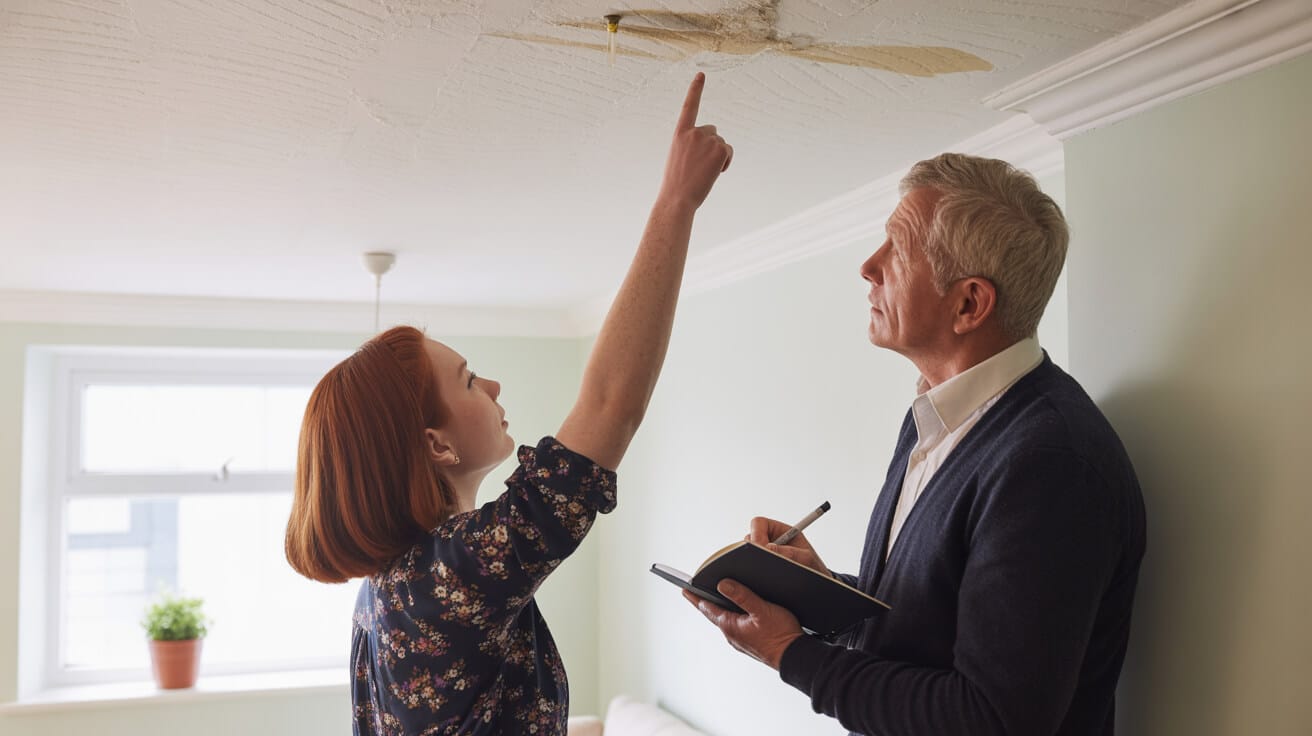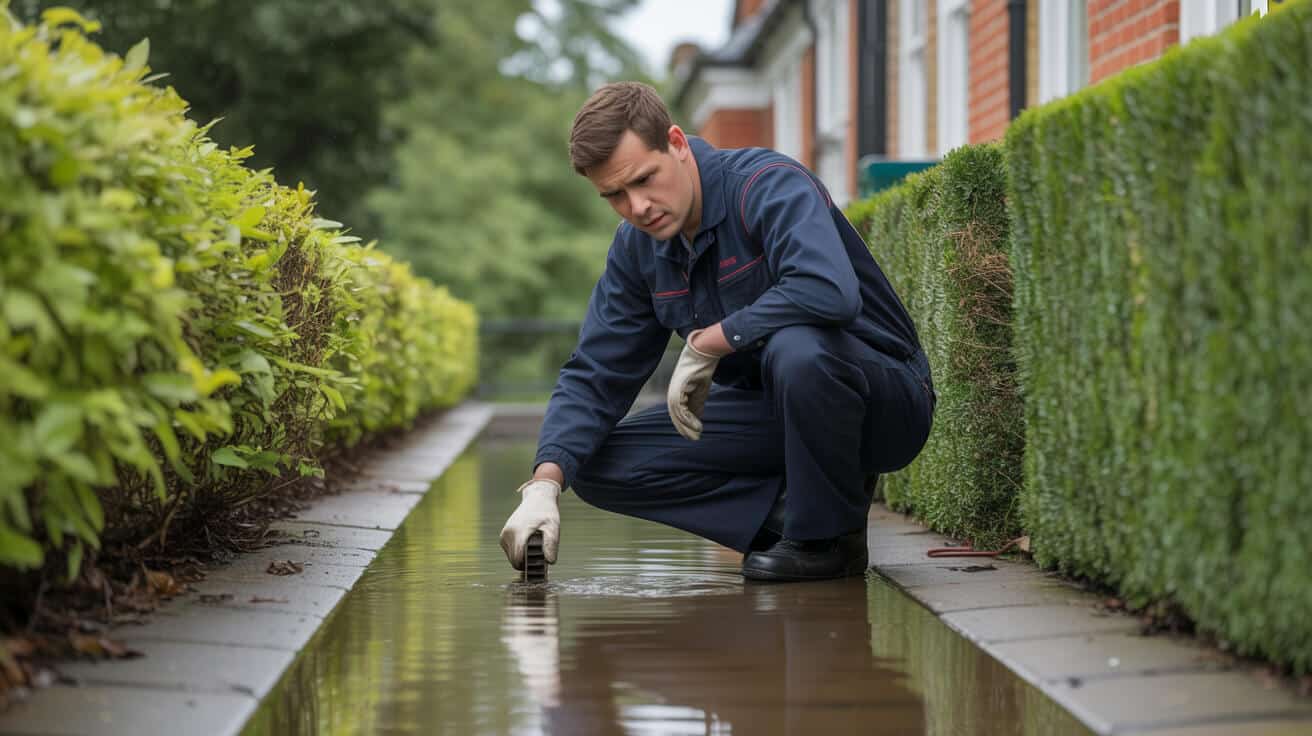 Preparing Your London Home for Winter Storms & Flash Floods
Preparing Your London Home for Winter Storms & Flash Floods

What’s Driving the Sudden Flood Risk in So Many London Homes?
Ask anyone in London—flood alerts aren’t just for riverside mansions anymore. These days, water hits basements, ruins tenancies, and stops property deals in areas that “never flooded in our lifetime.” For the first time, average homeowners suddenly find themselves on the frontline, and landlords are torn between insurance confusion and fixing the mess.
The causes are hiding in plain sight. Two factors have changed the rules: (1) relentless storms with more rainfall in hours than used to fall in a week, and (2) a Victorian-era drainage system that isn’t built for our climate—or for all that hard paving, garden resin, and roofline development that modern life brings. Those new patios? They’re sending every raindrop to the street faster than ever, overloading drains every time.
But weather isn’t the whole storey: Insurance policies have hardened. Unless you can show every pipe, valve, or drain has been properly checked, logged, and upgraded, claims get “paused” or outright denied. Even small things—like missing one service record or skipping a compliance certificate—flip your status from “covered” to “fighting for payout.”
The new reality is this: you can have a perfect record on your side—and still take the hit if a neighbour’s missed repair routes water your way.
The numbers show it. Flood-related claims in London surged by 18% in just five years, and the average repair bill has climbed well above £30,000—while payouts shrink for those lacking proper paperwork (Met Office 2023; citywideplumbers.co.uk 2024). Basement flats? Once cheap, now uninsurable for many. Landlords housing multiple families or running managed portfolios have even more to lose if their maintenance chains aren’t airtight.
Biggest risk clusters in London:
- Ground-floor and basement properties: Floodwater always flows to the lowest spot—cellars, storage, and sub-floor pipe runs.
- Victorian semis and terraces: One leaky fix, even next door, can cross over thanks to shared drains and ageing infrastructure.
- Installations without full compliance records: DIY repairs and uncertified work put both insurance and future sales at risk.
Every postcode’s in sights now. The difference isn’t whether it might flood, but whether you’re set up to bounce back—or just left untangling bills and red tape for a year after the water goes.
What Should You Do Immediately If Your Home or Building Floods?
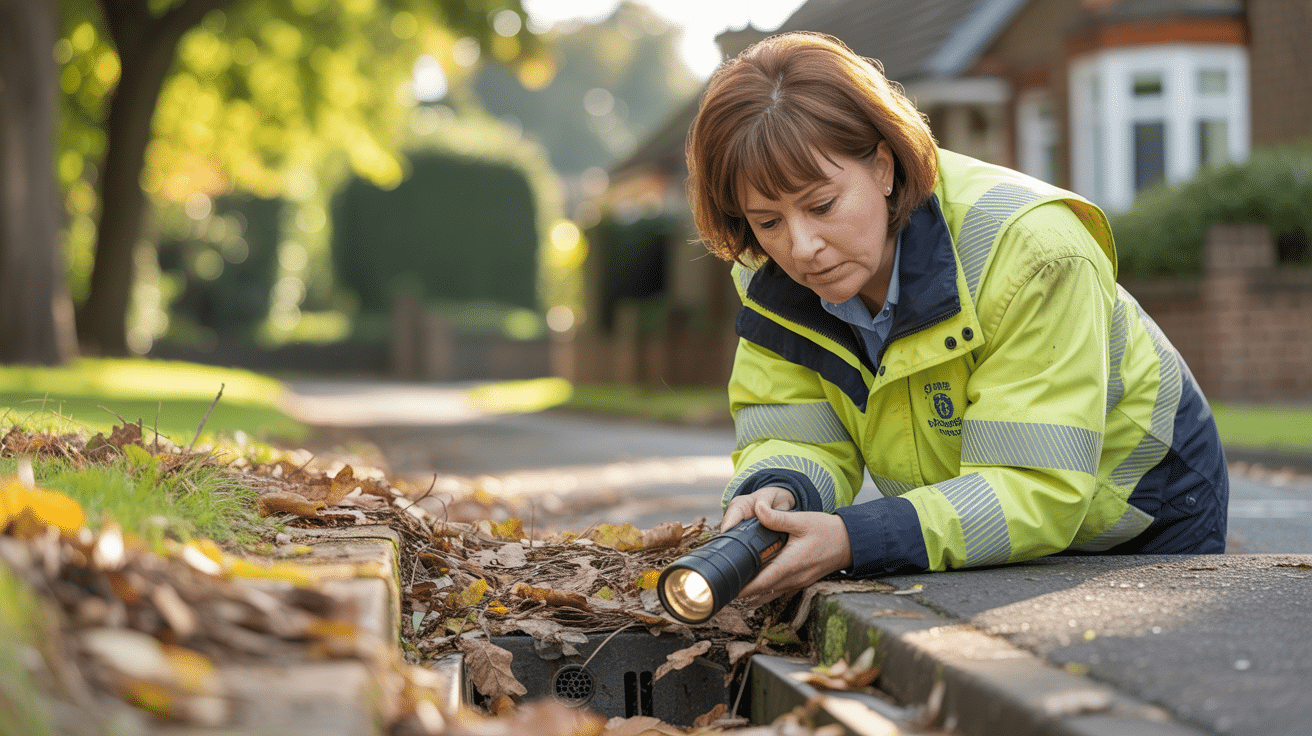
Londoners know: the first move during a flood is your lifeline. The worst mistake? Freezing or scrambling for gimmicks. Those who recover fastest follow the safety-first sequence—never the hype.
Step one: Protect people first. Clear everyone out of harm’s way—upstairs if safe, next door, or out entirely. Never wade into floodwater unless you know the sources: electricity, sewage, and sharp debris all lurk where you can’t see. For agents or block managers, check on elderly, disabled, or otherwise vulnerable tenants—liability is real.
You can’t choose the storm, but an organised response buys time and makes insurers listen.
If safe: isolate mains supplies. Water, electric, gas: every property has cut-offs—know them before the crisis. Make it standard practice to point these out for any new tenant or buyer. Fumbling in the dark burning cash and sanity.
Call 999 for danger to life or property, especially tenants trapped inside, elderly, or young kids. Once the site is safe, start recording every minute: photos from several angles, timestamped logs of every action, and a running note of all official instructions (trust us—insurers want this, and so do the authorities).
No patchwork repairs. Wait until water’s gone, then call in certified help for triage. Hidden damage multiplies if not flagged now—damp seeps, pipe joints crack, valves corrode behind plaster, and electrics quietly fry. Professionals know what to check and how to document it. Skip this, and minor leaks turn to six months of follow-up bills—and no insurance safety net.
The reality? Fast, methodical action beats panic or false economies every time. For managing agents and portfolio landlords, drill this response—because your reputation and financial outcome both hinge on what happens in those first 30 minutes.
Which Plumbing Checks and Upgrades Stop Most Flood-Related and Winter Damage?
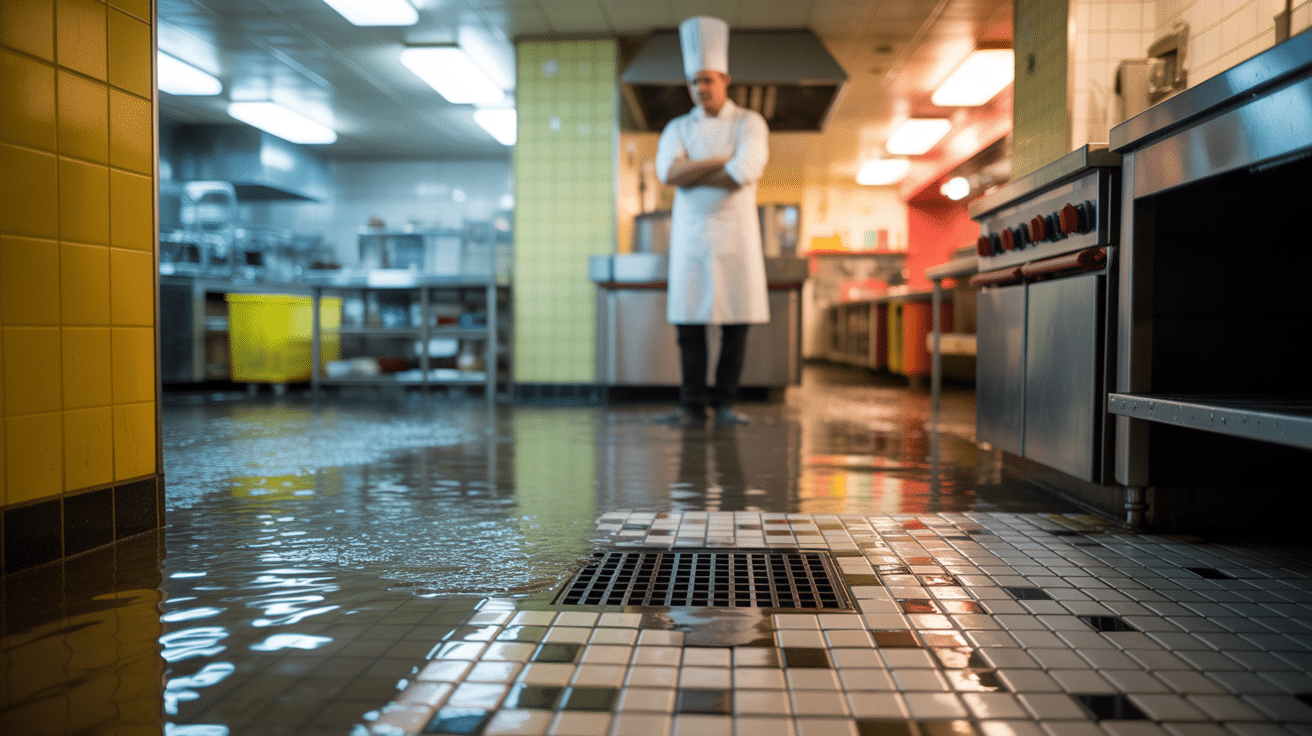
It isn’t dramatic gadgets that protect London homes—it’s detailed prep and compliance. Now, insurers treat proof of maintenance, logs, and qualified certificates as a deal-breaker. This isn’t just about winter—it’s about being future-ready, whether you’re a hands-on owner or managing 40 units in a block.
Your non-negotiable protection checklist:
- Insulate every vulnerable pipe.: External walls, lofts, metre cupboards, garden taps—all need WRAS-grade lagging. Miss one, and you hand opponents all the evidence for a denial when pipes burst from frost.
- Keep key rooms above 12°C.: Sounds trivial, but letting a flat “go cold” voids a huge swathe of burst-pipe cover. Digital logs or smart thermostats? Even better: they become instant proof if an adjuster wants to challenge a claim.
- Book annual boiler and system checks—always with proper sign-off.: WRAS/WaterSafe paperwork, Part G, Service history—filed and digital. For block landlords, centralise logs so nothing’s buried in a drawer or a phone that’s lost when the manager moves on.
- Drain down or isolate outdoor taps.: A leaky garden tap or undrained hose is the cliché agent of winter disaster—disconnect, shut off, and log it.
- Service unvented cylinders and check safety valves.: G3-qualified engineers only—no shortcuts. Flooded cylinders after a freeze or storm? They’re not just a property risk, but a safety one. Keeping all records is required—no “he said, she said” six months later.
An ounce spent on compliance returns a pound of repair avoided and a smooth claim when disaster hits.
Professional plumbers (like Plumbers 4U) don’t just fix, they document and prepare your systems to insurer specs. This starts a record that pays off not just for emergencies, but for property sales, rentals, and even new mortgages. Fly-by-night jobs or quick patch-ups? They’re the number one way to end up paying all of it yourself.
How Do Small Drain, Sump, and Gully Issues Cause Major Floods in London Weather?
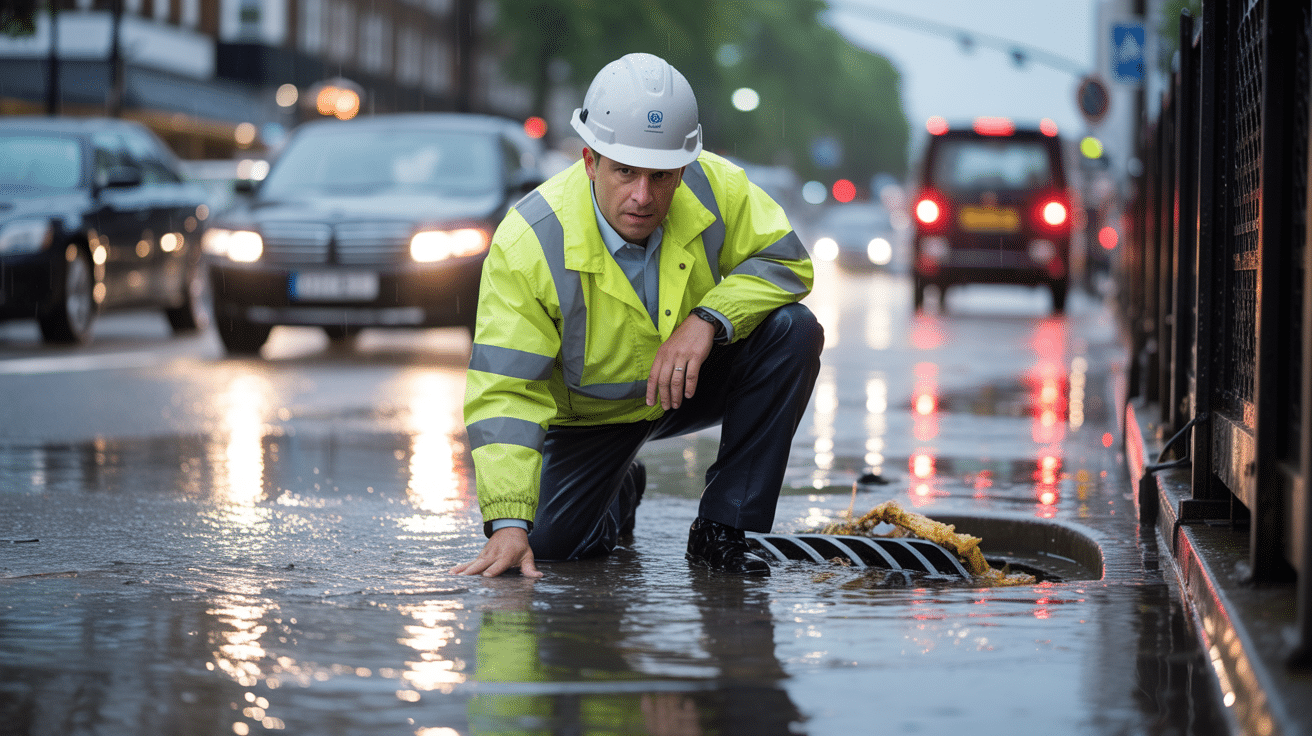
Flash floods rarely begin with drama—they start with a drain, gully, or gutter that’s been neglected, blocked, or rigged wrongly for modern stormwater surges. The proof is everywhere in London flats, cellars, and garden-adjacent homes. Fixing this is less about heroics, more about systematic, boring checks (that pay out big).
Critical actions before the next storm:
- Clear your gutters and downpipes,: not in October, but right before freeze or heavy rain is forecast. Even a palmful of moss, leaves, or bird fluff can redirect litres per minute right into shared drains, or behind exterior walls.
- Check that drains and gullies clear water quickly post-rain.: After any deluge, walk round—if standing water lingers for even ten minutes, it’s time for a flush, jetting, or pro-level inspection. Many old pipes are partially collapsed or silted—a fact often missed till it’s too late.
- Know your backflow protection.: Non-return valves must *exist* and be logged for insurance and building compliance, especially in ground-floor, basement, and shared-ownership scenarios. If documentation’s gone missing, book an inspection and get that certificate uploaded and backed up this month.
- Test and log sump pumps (if fitted).: These might seem “extra” till you watch a neighbour’s fail during a storm. Most claims denied post-flood cite “pump not maintained” or missing activation records—photo log every test, ideally monthly.
A £50 block clearance can prevent a £20k claim fight and six-week disruption during lettings or refurbs.
Sharpest landlords and managing agents don’t just rely on cleaners or annual “gutters only” visits. They hire plumbers able to log every risk, certify backflow valves, and hand over a PDF or cloud record that sells your compliance at the next renewal or sale.
What Happens Inside Your Plumbing After a Flood—And How Do You Block the Chain Reaction?

The real pain of winter floods lives below the surface: contaminated water, hidden leaks, compounded breakdowns, and escalating damage weeks later. The hard costs hit slow—one ignored check triggers a domino effect that costs thousands.
The chain you need to break:
- Backflow—when it fails, sewage or dirty water can score interior pipes and contaminate drinking supply.: Always have these checked after *any* flood—even partial.
- Gullies and traps—blocked or half-full with debris—send water up through kitchen or ground-level drains.: Ignore the slow rise, and it turns into an expensive clean-up.
- Subsurface fractures happen quietly.: London’s saturated soil in winter can crack old clay and plastic, leaving leaks invisible except for increased bills or faint sound. Pressure or thermal imaging from a proper plumber is the only sure test.
- Boilers and cylinders should stay off until cleared.: Restarting heating or hot water after water intrusion risks short-circuiting cores, sensor faults, or even dangerous explosions in rare but real scenarios.
The longer you wait on repairs or documentation, the worse it gets. Insurers spot a chain of delayed checks—and use that as leverage to limit or deny payout. Speed, proper logs, and chase-downs by those who know the quirks of big London buildings are the only way to block the domino effect before it bankrupts your winter.
How Can Documentation Be the Difference Between a Paid-Out Claim and an Insurance Nightmare?
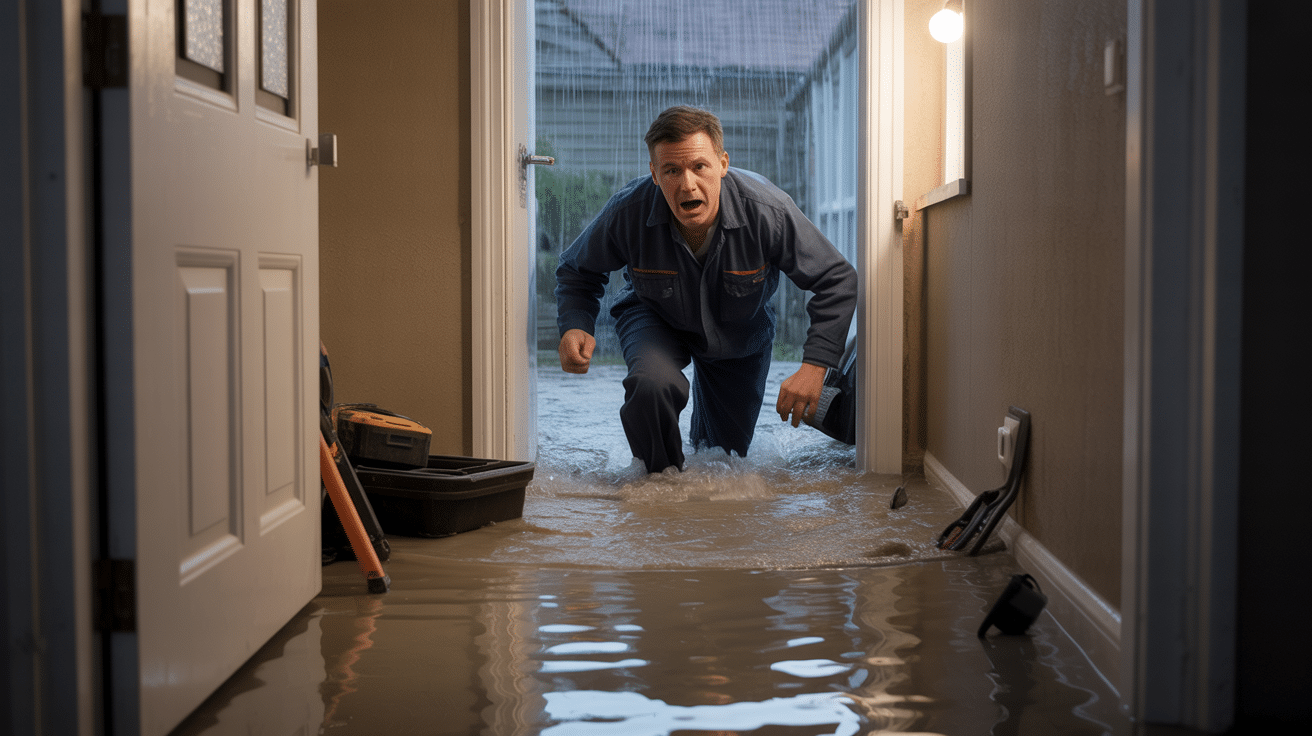
Insurance in 2024 is cold logic: if you can’t prove it happened, it didn’t. If your file’s a mess, you wait or pay yourself. Complete, certified records are now your fastest route from disaster to recovery—no exceptions for “trusted clients” or “longstanding relationships.”
Your documentation playbook:
- Photograph every step: —before, during, after: incidents, professional interventions, repairs. Time-stamp if possible.
- Keep a running log,: including every call to pros, agents, tenants, and your insurer. Log names, times, clear sequence.
- Digitally back up and share: cloud, WhatsApp, or manager portals.: This stops disputes, lost paperwork, or slowdowns during sale or letting.
- Insist on every compliance certificate: WRAS, WaterSafe, G3, Part G. For anything from minor fixes to major refurbs, keep them filed and easily retrievable. Download templates for your property or block.
- Document every direction from your insurer,: especially in crises. If they tell you to “wait for an adjuster” or “get a drain log,” keep record.
Your paperwork is as essential as your pipes—it builds the bridge from flooded property to a resolved, covered outcome.
The best professional plumbing services provide records by default, with live upload portals or physical job books. This isn’t “extra”—it’s the blueprint for every calm claim, re-listing, or handover.
Which Compliance Documents and Certificates Actually Matter in a Flood or Sale?

In “old” London, a plumber’s bill and a hand-written note sufficed. Today, your property’s future protection and market value depend on the stack of digital records and compliance sheets you hold. This is the toolkit that unlocks insurance, secures lender approval, and gets legacy sales across the finish line.
Non-negotiable paperwork:
- WRAS and WaterSafe certification: Anything involving pipework, water appliances, or fixtures needs this—no exceptions. A DIY “patch” or unmarked fix is visible sabotage to your next claim or sale.
- G3 (Unvented) and Part G (Water Safety) certificates: Always supplied by professionals for hot water/pressurised work. Expect and demand them—without, refurbs or restorations stall and insurers may refuse the lot if there’s a serious burst or injury.
- LABC sign-off for system overhauls: Main drain changes, new zone valves, moves on boiler/cylinder locations, or heating block reworks? They all require “notifiable works” evidence—deal-killer if missing at sale, refinance, or big rental agreements.
- Annual and maintenance logs: Download, print, and digital copies—no “I’ll get that from the office later.” Update after every engineer’s visit.
Many landlords and agents have learned this the hard way after a denied claim. “Proof in the cloud” isn’t a luxury now—it’s the new insurance baseline. Set this up now, or chase it in distress later.
Do You Really Need a Professional Triage—or Just Fast Repairs?
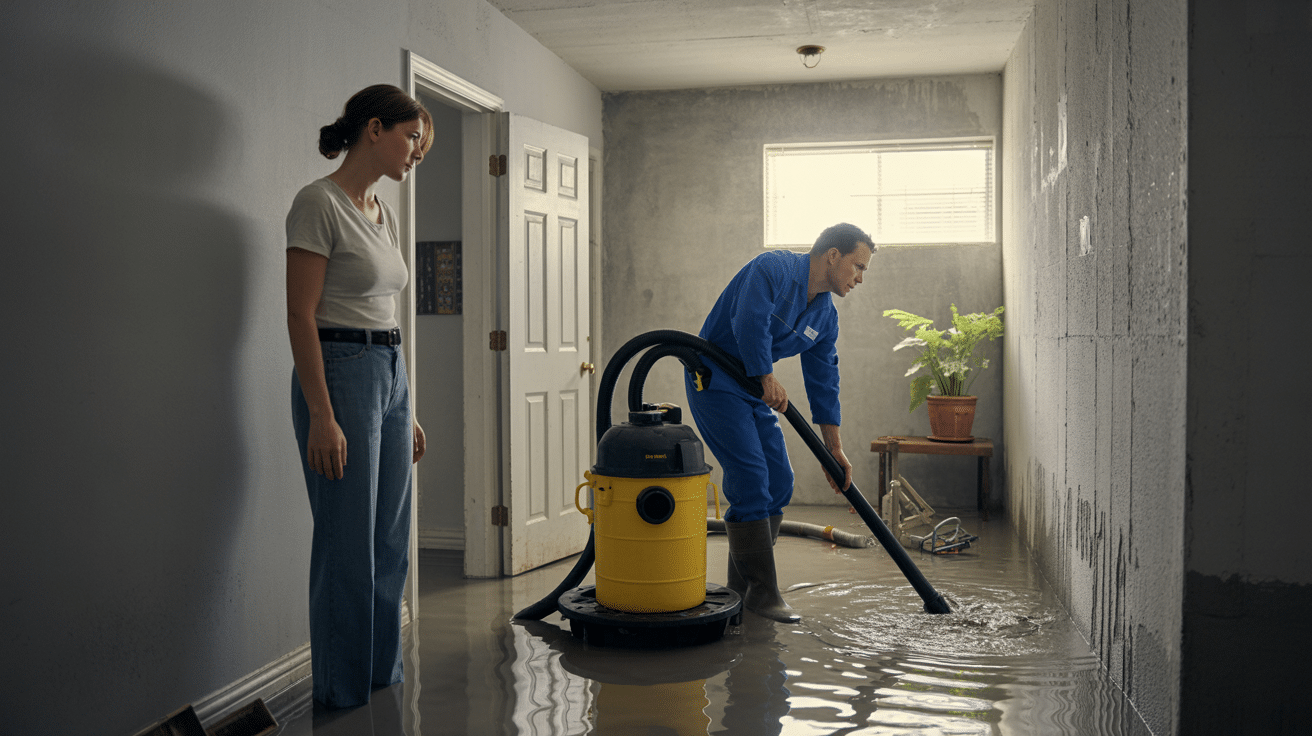
When water’s everywhere or winter’s bit hard, urgency tempts short-cuts: a cheap unlogged repair, or a friend who “knows plumbing.” It solves little—and often multiplies cost and hassle. A professional triage isn’t just fix-and-go; it’s a full map and check of every point of risk, end-to-end, with proof that makes insurance, lenders, and buyers say ‘yes’ instead of ‘prove it.’
What a real triage provides:
- End-to-end inspection: Every vulnerable, hidden, or downstream risk is surfaced—no missed damage that comes back to haunt you.
- Documented pricing and part codes: No guesswork, but line-item detail for your records and peace of mind.
- Credentials presented up-front: Qualified pros show WRAS/WaterSafe/G3/CSCS evidence—ensures coverage is solid and compliant *before* any tools come out.
- Aftercare and future-readiness: You get digital logs, how-to advice, and check reminders—no surprise fees, just proper support. Managing a block? Whole-property summaries delivered to agents or owners.
- Legacy-building: Using compliance-focused services like Plumbers 4U means every logbook grows stronger. That’s your shield and customer storey when you sell, refinance, or handle a claim.
In a world where a missed gasket or a lost certificate can cost tens of thousands, pro documentation and transparent triage aren’t “nice to have”—they’re your survival plan.
Ready for London’s Next Flood? Why Plumbers 4U Is the Only Call You Need
Floods aren’t rare. Insurance is harder. Regulations are stricter. The only way to own these challenges? Proactive, compliance-led plumbing from experts who log what matters, anticipate insurer demands, and care about repeat clients, not one-off rescue jobs.
Plumbers 4U puts you in control:
- Full transparency, every step.: Know costs, timelines, and credentials before you start—no runaround, no leaps of faith.
- Compliance-first approach.: WRAS, G3, WaterSafe, and CSCS registration ready. You get job sign-off, full paperwork, cloud backups, and proof for claims, sales, or regulatory challenges.
- Digital aftercare as standard.: Logs, photos, annual reminders, and walkthroughs included—with no nickel-and-dime billing.
- Instant readiness, anytime.: Submit a job, upload photos, or request urgent advice—before the pipes go, before it’s too late.
“Repair it right, document it now, and give yourself lasting peace of mind—no matter what the forecast or market brings.”
If you’ve read this far, you’re not the type to risk a shortcut—so don’t risk the flood, the denied claim, or that failed sale. Plumbers 4U is your pro partner year-round, the only name you need for winter floods, compliance, or legacy-building for every property you own, let, or manage. Book your flood and winter check today, and put the odds—and the paperwork—in your favour.
Frequently Asked Questions
Who faces the greatest winter and London flood plumbing risk right now—and how can you preempt disaster?
Properties most at risk for winter freeze and flooding in London are basement flats, ground-level terraces, older conversions, and multi-unit buildings—especially in dense boroughs where outdated pipe runs and shared drains are the rule. But the sharpest risk isn’t just about postcode lines or a Thames water warning; it’s that stormwater and groundwater now travel wherever drainage and maintenance weaknesses allow. Owners and managers in places like Southwark, Tower Hamlets, Ealing, and even “safe zone” areas are witnessing new kinds of claims: damage that appears overnight, with insurance now scrutinising not just weather maps but the presence of plumbing documentation and resilience proof.
Floodwater always takes the shortest route—often straight through your least-checked pipe or gully.
Shared layouts—Victorian conversions, maisonettes, and mid-century flats—are especially vulnerable because a neighbour’s neglected debris or unseen backflow fails can endanger your home as much as your own maintenance gaps. In 2024, insurers and local authorities are flagging older, multi-unit, and low-lying properties for pre-emptive action. If your building’s drains have ever backed up, or you’re connected to unmanaged land, don’t wait for visible water—pre-booking an annual resilience check and assembling compliance logs are no longer “best practice”: they’re the difference between a rapid payout and a rejected claim.
What signals indicate urgent winter plumbing and flooding risk?
- Basement, garden-floor, and split-level units in older or denser developments
- Properties sharing soil stacks or drains, especially on boundary edges
- Flat roofs, blocked gutters, hard landscaping, and areas with recent flash-flood history
- Case clusters: postcodes where claims have doubled (SE1, N7, E2, W9)
Insurer underwriting has gone fully digital: maintenance records, real-time photo logs, and WRAS or G3 certificates now ‘travel with the flat’—while missing paperwork regularly sparks higher excesses, reduced settlements, or even coverage refusals. If your property ticks any of these boxes, acting now is the financial safeguard that protection plans once promised.
What emergency steps and documentation prevent loss escalation after a London flood—even when help won’t arrive immediately?
When floodwater hits, every action—from power isolation to evidence gathering—shapes how medical safety, insurance claims, and repairs unfold. Electrical risk surges in London’s densely populated blocks with communal metres or basement risers; stagnant water hides shock and sewage threats. The correct first move is evacuation to a higher level or safe exit—never risk personal retrieval from submerged areas.
If no immediate risk exists and access is possible:
- Cut power from the main board (ground floor or metre room).
- Close the water stopcock to halt any mains-powered ingress.
- Take rapid, timestamped photographs of all damage and flooding as it evolves; insurers now favour real-time digital trails.
- Begin a detailed, time-stamped event log: every step, call, or system change. These serve as core claim evidence, especially in multi-unit properties or where blocks/landlords are involved.
A digital chain of proof now unlocks repairs, payouts, and future rating protection—the moment trouble starts.
What to do when isolation points or electrics can’t be reached?
- Never step into water near outlets or electrical panels.
- Contact the building’s emergency service, property manager, and your insurer’s 24-hour line.
- Aid children, elderly, and mobility-challenged occupants first. Keep access routes clear for emergency personnel.
UK insurance adjusters confirm that missing digital evidence, poor logs, or delayed action now derail more claims than rainfall does. Fast updates and verifiable documentation—from simple phone photos to damage logs—not only streamline repairs but reduce landlord and property manager liability for delayed response.
Why is precise, digital winter plumbing documentation now the linchpin for both property value and insurance success?
More than half of last winter’s denied London insurance claims came back to a single point: a lack of scheduled, photo-verified plumbing maintenance. The main triggers? Pipes unlagged in vulnerable places, external taps not drained or isolated, unserviced cylinders, and lack of compliant boiler checks. In the current market, WaterSafe and major underwriters require annual checks with timestamps, engineer IDs, and before-and-after evidence—especially ahead of the first cold snap.
What must a professional winter plumbing visit cover to ensure compliance?
- Wrap and insulate every exposed or peripheral pipe: check cellars, outhouses, garages, and external walls.
- Test all isolation valves: confirm they turn freely and deliver a full shutoff.
- Drain and isolate garden taps, secondary water lines, and unheated outbuildings.
- G3-certified (unvented) cylinder inspections for all high-pressure hot water systems.
- Complete WRAS-compliant documentation for all works, stored digitally and shared with your agent or landlord.
Fail to photograph-prep your winter checks and every claim turns into an uphill argument—protection only counts if it’s proved in real time.
How does a robust digital documentation pack look?
- Photos showing each major intervention both before and after
- Job logs and PDF certificates for regulated and safety-critical work
- Uploads to secure, cloud-based folders with engineer, date, and address searchable
Whether you’re planning to sell, refinance, or simply avoid a rejected claim, this digital pack is now leverage—streamlining everything from surveyor signoff to property tax reassessment.
How do overlooked drains, gutters, and communal pipes drive London winter insurance denials—and what stops the cascade?
The culprit in most catastrophic London winter floods isn’t always an overwhelmed Thames or a burst water main: it’s ignored downpipes, neglected soakaways, and missed gutter cleans. Blockages and mechanical failures account for over two-thirds of surface flood and home entry events, especially after freeze-thaw swings and autumn leaf fall (Thames Water Study 2023). Most claims disputes aren’t about force majeure; they hinge on “lack of preventive evidence,” meaning no photos or logs before the event occurred.
Where do most maintenance gaps hide?
- Gutters, downpipes, and gullies that overflow or pool water for longer than 8–10 minutes post-storm
- Sump pumps or check valves not documented with an annual test or maintenance log
- DIY fixes on communal systems or private land, especially if repairers can’t provide WRAS/WaterSafe certificates
Every missed log or overdue clearance tips the odds toward disaster—the block manager’s folder matters more than any forecast.
How do landlords, property managers, and homeowners create audit-proof records?
- Commission written and photo-logged clearances on a set schedule (at least twice per year; more in leaf-prone areas).
- Centralise reports in a shared digital binder or management portal.
- Require every engineer visit or fix to supply full post-task evidence (photos, signed log, date/time).
Start this routine and outcomes shift: claims sail through, surveyors drop red flags, and insurance ratings reflect actual risk reduction—not just postcode group averages.
What delayed or missed post-flood plumbing checks risk hidden danger and insurance shortfall—and how are they safely managed?
The greatest financial risk post-flood in London isn’t spongy carpets or obvious leaks. It’s silent: backflow through under-serviced drains, concealed water deep in floors or walls, and undetected stress to hot and cold supply lines. Major insurers confirm that claims double in size—and are more often denied—when professional post-flood reports and pressure/moisture tests are postponed or skipped.
Which scenarios demand immediate certified checks after flooding?
- Sewage or foul-water backflow into flats when communal valves or private check valves haven’t had a recent service log
- Invisible ingress under wood, behind skirting, or inside boxed-in pipes—often months from first noticeable odour or damage
- Any system run (water heaters, cylinders, boilers) that was soaked, submerged, or exposed to contaminated water
The costliest claims don’t begin with a bang—they start with a missed inspection after the danger seems to pass.
What is the post-flood protocol for building integrity and safety?
- Do not switch on any electrics, heating, or hot water until system pressure tests and full moisture checks are greenlit by a WRAS/WaterSafe engineer.
- Gather all digital documentation—receipts, logs, images—immediately for your block manager or insurer’s portal.
- Arrange for an inspection inside 24–72 hours post-incident; delay here leads to policy exceptions and outright denials.
Prioritise evidence-logged diagnostics over quick fixes—owners and block managers who treat post-floods as a tick-box “cleanup” now pay the highest price in denial and secondary loss.
How does robust, certified plumbing documentation now determine your insurance, resale, and legal outcome in London?
London’s market is in a documentation revolution. Estate agents and insurance underwriters ignore claimant stories and focus on signed, timestamped digital reports, G3/WRAS/WaterSafe certification, and five-year record trails. Incomplete digital files are increasingly the top reason for rejected claims, delayed sales, and failed mortgage refinancing across the capital.
What constitutes an insurance-or mortgage-grade compliance file today?
- Time-stamped, geo-tagged before/after logs for every heating, plumbing, or drainage intervention (especially in multi-unit properties)
- Attached certificates for all regulated works, in formats approved by insurers and underwriters
- Proof stored in redundant locations: online cloud systems, managing agent portals, and personal hardware
- Complete, cross-referenced job sheets for a five-year minimum period (or longer for large-block or commercial stock)
Compliance documentation has become the new capital—missing files choke sales and claims faster than any weather front.
How have insurance and survey standards shifted in 2023–2024?
- Insurers now reject thousands of claims per year based on absent or unclear digital proof—even in “covered” incidents
- Mortgage approvals and sales timelines are now at the mercy of how fast you can produce your full compliance pack
Owners prepared with full, accessible digital files now see everything from insurance results to sale prices increase—while those who can’t produce files on demand are rapidly penalised.
What gives Plumbers 4U clients a decisive advantage in winter risk protection, claims, and property value?
Smart property managers and owners don’t “wait for the cold-weather call;” they secure booked, certified triage visits by WRAS/WaterSafe engineers, who create full compliance records on the spot, backed by 24/7 digital support and instant shareable certification. Every visit from Plumbers 4U generates a fully managed file: date-stamped photos, signed logs, certificates, and evidence always ready for agents, loss adjusters, surveyors, or buyers.
You receive:
- Fixed-fee, engineer-led winter resilience reviews with all works documented for audit—no hidden surprises or upcharges
- 24/7 emergency routes, live status updates, and digital access to compliance records for every stakeholder
- Forward-curated property files that prepare you for insurance, block management, mortgage negotiations, and sale/let transactions on your terms
Choose Plumbers 4U and stay ahead of winter: fortify your compliance record, unlock better rates, and ensure every claim and survey works in your favour. Booking a winter resilience audit now means putting control—and certainty—back in your hands, before the next cold front or flood threatens your peace of mind.

